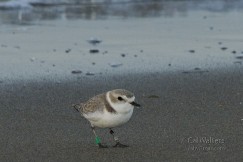
Lately, the favorite part of my day has been monitoring some wintering western snowy plovers that came to Crown Beach in November. Their appearance was first noticed by some volunteer birders who were doing the annual shorebird count around San Francisco Bay. The sand restoration project, which brought nearly $6 million worth of sand dredged from the bay floor around Angel Island and pumped from a barge onto the beach, was just finishing up. The new darker sand, heavy with bits of shell, must have attracted the small flock of plovers. Their favorite winter habitat is a stretch of sandy beach backed by dunes, exactly what Crown Beach offers. That’s also their favorite nesting habitat, which is part of the problem and one of the reasons they’ve been listed as a “threatened species” under the Endangered Species Act. In 1993, it was estimated that only 1,500 snowy plovers remained in the Pacific Coast population due to habitat loss and predation.

One of the plovers I’ve been watching has four colored bands on its legs. Cindy Margulis, a local birder, and Karine Tokatlian, Plover Program Director with the San Francisco Bay Bird Observatory (SFBBO), identified this little snowy plover and traced out its life story. Hatched in June 2009 on the South Bay salt ponds, the chick was banded along with 112 other snowy plover chicks that year. That winter it turned up in Half Moon Bay, then returned in spring 2010 to the South Bay Salt Ponds. The next couple of years no sighting was reported, but this winter it’s hanging out on Crown Beach with up to thirteen other snowy plovers. This represents 10% of the Bay Area’s snowy plover population. Karine relayed to me, “It’s common for the snowy plovers to move between the Pacific Coast and the bay and even go as far east as the Central Valley. They don’t migrate far distances like some of our shorebirds who nest in the Arctic and winter along San Francisco Bay.”
For a two-ounce bird that would fit in the palm of your hand, there are many threats they overcome to survive even the average lifespan of three years. Their main survival strategy is concealment, hiding in plain sight. The bird monitors and I have stood with binoculars and scopes and counted the visible birds multiple times, only to find we’ve overlooked one or more. Their camouflage helps them hide from predators such as gulls and ravens. Unfortunately, these predators can decimate the nesting site once it’s discovered. Last year, the South Bay salt ponds hosted the majority of Bay Area nesting snowy plovers with 174 nests. SFBBO discourages California gulls from nesting on nearby habitat to help the snowy plovers.They also improve the nesting habitat by adding oyster shells to provide better camouflage elements for the adults and chicks.

Wildlife agencies are trying to balance the mandate to return the salt ponds to tidal action and preserving a portion of them for plover and least tern nest sites. The hope is that with habitat preservation, restoration and predator controls the snowy plover population will return to sustainable levels. Success will be achieved when the snowy plover population reaches 3,000 birds and is maintained over the course of at least 10 years. You can help these threatened birds survive by not disturbing birds resting or nesting on beaches. You can also report banded snowy plovers to SFBBO on their website to help them learn more about snowy plover survival rates and movements.
Additional information: “Snowy Plovers a Welcome Surprise at Alameda Beach.” (San Francisco Chronicle)
